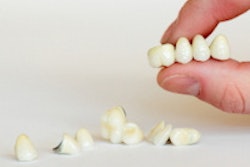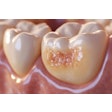
All-resin-composite crowns may be more durable than all-ceramic crowns, an international team of researchers will report at the International Association for Dental Research (IADR) annual meeting in July in Barcelona, Spain.
"In my research, I found [Paradigm MZ blocks] to be very resistant to fracture when you make molar crowns of them," said Omar El-Mowafy, B.D.S., Ph.D., a University of Toronto researcher who collaborated with two colleagues in Egypt on the study. "They are also very gentle to the opposing dentition -- they don't cause accelerated wear."
Currently, only a small fraction of dentists are placing this type of crown, but the approach could catch on fast if longer-term clinical studies bear out these results, he said.
The trio subjected 16 resin-composite crowns (Paradigm MZ blocks, 3M ESPE) and 16 feldspathic all-ceramic crowns (Vitablocs Mark II, Vita Zahnfabrik) to 1 million cycles of compressive force in a universal testing machine. This is roughly equivalent to four years of use, since people perform an average of 250,000 masticatory cycles per year.
The crowns were all created using CAD/CAM technology (Cerec 3D system, Sirona Dental Systems), which dentists can either do themselves or have a laboratory perform.
“In my research I found Paradigm MZ blocks to be very resistant to fracture when you make molar crowns of them.”
— Omar El-Mowafy, B.D.S., Ph.D.
Eight crowns in each group were cemented to their respective recently extracted, caries-free molars with self-etching resin cement (Panavia F2.0, Kuraray), and the other eight in each group were cemented with self-adhesive resin cement (RelyX Unicem Clicker, 3M ESPE). One hour after cementation the teeth were stored in water at 37° C. A week later they were subjected to the cyclic-loading test.
Each of the composite crowns survived the test intact, but three of the ceramic crowns developed surface cracks at the center of the occlusal surfaces that extended laterally. All three of the cracked crowns had been cemented with the self-etching resin cement.
However, the researchers found significantly less microleakage from the ceramic crowns cemented with Panavia F2.0 than from crowns in the other three groups. The team believes this difference might be related to the mechanism of adhesion of each cement. The Panavia F2.0 is composed of lower-molecular-weight monomers that subsequently diffuse selectively into dentin, though Dr. El-Mowafy acknowledged that this doesn't explain why the resin-composite crowns bonded with Panavia F2.0 had more leakage than the ceramic crowns bonded with the same cement.
The study was partially funded by the Egyptian Ministry of Higher Education, with sample materials provided by the manufacturers. The team has submitted the most recent results for publication.
Similar findings
This isn't the first time Dr. El-Mowafy's group has shown good results with Paradigm MZ, which 3M ESPE calls "the only radiopaque composite blocks available." In a 2009 IADR presentation, the team compared the fracture resistance of 20 crowns made with this material to that of 20 all-ceramic crowns (Empress-CAD, Ivoclar Vivadent). The two types of crowns were able to withstand similar loads, but only 30% of the ceramic crowns survived 500,000 cycles of loading.
In another recent study (Journal of Dentistry, January 2010, Vol. 38:1, pp. 16-22), researchers found minimally prepared resin-composite crowns had similar fracture loads to leucite glass-ceramic crowns (ProCAD, Ivoclar Vivadent).
And in a study from the Journal of Adhesive Dentistry (December 2009, Vol. 11:6, pp. 493-498), investigators published five-year results on metal-free composite crowns made of methacrylate (Artglass, Heraeus Kulzer). The study included 114 teeth of 71 patients ages 20-81 years who needed a crown because of carious destruction, but who did not have extensive teeth destruction. The teeth were randomized to two modes of preparation of the ceramic composite crowns.
The crowns in one group were prepared with a 0.5-mm chamfer finishing line, while those in the other were prepared with a 0.5-mm shoulder combined with occlusal reduction of at least 1.5 mm. The buildups were also completed with the composite material, using the corresponding dentin adhesive. The crowns were manufactured in a laboratory using stone dies and were adhesively luted intraorally with resin cement.
After five years, there were 18 complications among the 83 crowns that were available for follow-up at that time. These included 13 major failures that necessitated replacement of the crown and five minor complications that could be repaired. Neither location nor preparation design were associated with a higher complication rate. (The study was sponsored by Heraeus Kulzer, and the company also provided most of the composite and adhesive materials.)
Underutilized?
Resin-composite crowns are less expensive than metal-ceramic or zirconia all-ceramic crowns, too. So why haven't they caught on? It just takes time, Dr. El-Mowafy said. "The majority of insurance companies don't pay for composite crowns," he noted.
But one of the Artglass study authors, Franziska Lehmann, D.D.S., from the University of Heidelberg, thinks dentists may be waiting for more research.
"Another reason for the underutilization of resin composite crowns might be that there are no data on their clinical success over five years or more, while ceramic restorations seem to have more promising survival results after mid-term and long-term clinical use," Dr. Lehmann told DrBicuspid.com.
Copyright © 2010 DrBicuspid.com



















